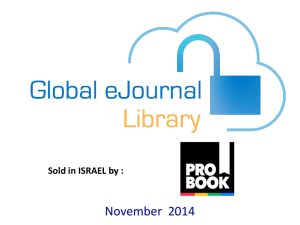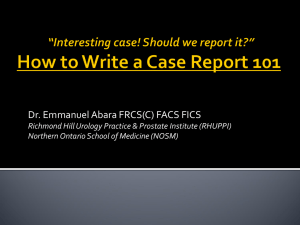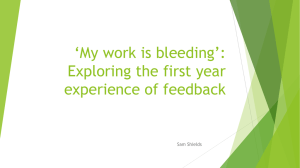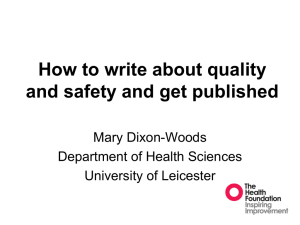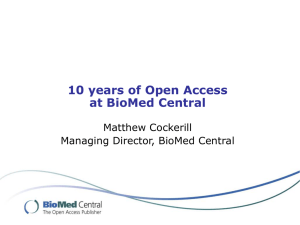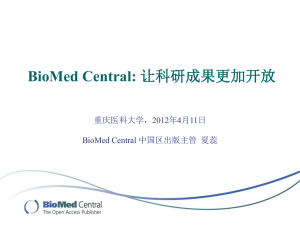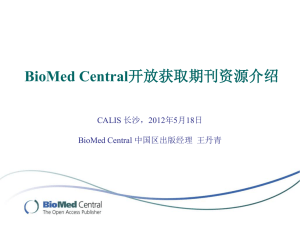BioMed Central and SpringerOpen
advertisement
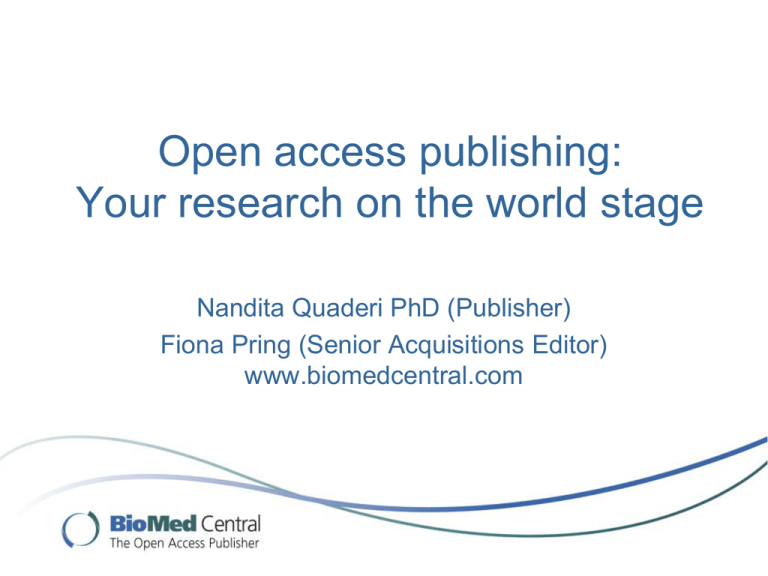
Open access publishing: Your research on the world stage Nandita Quaderi PhD (Publisher) Fiona Pring (Senior Acquisitions Editor) www.biomedcentral.com BioMed Central • Largest publisher of peer-reviewed open access (OA) journals • Launched first open access journal in 2000 • Now publishes 230 OA journals • >100,000 peer-reviewed OA articles published • Became part of Springer in 2008 • Hosts SpringerOpen • Membership scheme What is open access? The old world of access to knowledge The new world of access to knowledge OA in brief • No subscriptions = no barriers to access • Published articles immediately available online for free for everyone! • Copyright remains with the author • Major OA publishers - Article Processing Charges (APCs) • Support from funding bodies and governmental agencies Advantages of open access • Very high visibility - Accessible from multiple sites - Indexed widely, eg PubMed - No barriers to dissemination • Quality - Acceptance rates based purely on the quality of the submissions Open Access Publishing, Then and Now… 2000 2012 And many more… Open access in 2012 • Over 7200 open access journals in the DOAJ • Over 1000 OA journals are indexed by ISI • Open access to research is now mandated in over 135 institutions and by over 50 funders • Submissions to OA journals grew by over 35% between 2009 and 2010 • OA firmly part of the mainstream Growth in OA mandates Source: http://www.openscholarship.org/jcms/c_6226/open-access-policies-for-universities-and-research-institutions?hlText=policies Impact Factor journals: open access market growth "Full" OA Journals Subscription Journals Share OA Articles 1,400,000 9.0% 8.0% 1,200,000 Number of Articles 6.0% 800,000 5.0% 600,000 4.0% 3.0% 400,000 2.0% 200,000 1.0% - 0.0% 2002 2003 2004 2005 2006 2007 2008 2009 2010 Share of Articles in ‚Full OA Journals 7.0% 1,000,000 Difference between subscription and open access models • Both have – Editors, peer review, are indexed in ISI etc, have similar production processes, obey publication ethics • OA journals also – Allow the contents to be immediately freely available online everywhere in perpetuity • Different business models The open access business model • Commonly financed by Article Processing Charges (APCs) - usually paid by funders, institutions, societies, etc • Some open access journals have central support, so no charges for authors or readers • No charges for access How authors cover APCs Results from survey by the Study of Open Access Publishing (SOAP) BioMed Central Membership • For BioMed Central, SpringerOpen and Chemistry Central journals • Institutions pay APCs in full or in part for their researchers • Over 380 Member institutions worldwide, including - Escola Nacional de Saúde Pública Sergio Arouca - Universidade Estadual Paulista • Ask your librarian to visit: http://www.biomedcentral.com/libraries/membership Open access in a Brazilian context • >650 journals in DOAJ • 239 journals in SciELO • Increasing numbers of submissions to BMC journals • Diabetology and Metabolic Syndrome • BMC journal Membership How Brazilian authors cover APCs 70 60 50 40 30 20 10 0 My institution paid the fees I used part of my research funding not specifically intended for paying such fees My research funding includes money for paying such fees I paid the costs myself Other Results from survey by the Study of Open Access Publishing (SOAP) Publish a journal with us • BioMed Central and SpringerOpen: – launch new OA journals – take on existing journals, both self-published and from other publishers • Speak to us if you’re interested! Case study • Brazilian Society of Diabetes • Launched 2009 • First Impact Factor due in 2012 Thank you! nandita.quaderi@biomedcentral.com fiona.pring@biomedcentral.com www.biomedcentral.com

